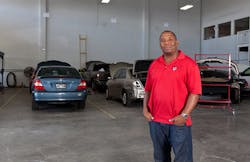Spencer Nash embraces Hawaii’s “aloha spirit.” He appreciates the kindness of the customers he interacts with at a pair of Honolulu body shops.
“I’ve been to a lot of places, and how people treat you [in Hawaii], it definitely puts a smile on your face,” he says.
Because of that, Nash never wants to let customers down. Nash wants visitors to both Auto World Specialists (where he serves as general manager) and World Class Auto Body & Paint (which he owns) to walk away pleased with all elements of the repair process.
That’s why the shop operator worked to become an I-CAR instructor. That’s why he established an in-house training center at AWS. And, that’s why he sought out every form of training he could get for his employees—even going so far as to talk an equipment vendor into flying from the U.S. mainland to Hawaii to provide onsite lessons. Historically, Hawaiian shops have especially struggled with technician training, as Nash noted in a 2014 FenderBender article.
FenderBender recently caught up with Nash, who helps oversee 33 total employees at two shops that combine to produce nearly $5 million in annual revenue. In the latest conversation, the Hawaiian explained how fellow shop operators can ensure that their technicians get the training they need in 2019.
Inspire enthusiasm from employees.
Sure, it’s easier said than done to get your staff excited about training—similar to how no one likes a trip to the DMV or the dentist. Yet, it’s not an impossible feat, Nash says.
He feels the key is providing hands-on lessons that illustrate the importance of taking measures such as following OEM repair procedures. Lately, for example, Nash has shown employees the proper steps to take if certain vehicle codes can’t be cleared.
“Normally, they might repair the car, put it back together, and push it down the road because everything looks good on the dash,” he explains. But hands-on teaching “shows them that, hey, even though it looks right, it can’t [necessarily] go home like that.”
Carefully create a budget.
In Honolulu, Nash takes great care to truly create a training budget for the shops he helps oversee. And, he revisits that budget every few weeks.
He suggests other shop operators “put the money toward training on a monthly basis, instead of trying to do all your training in this little window before, say, your I-CAR certification expires—that’s what I see as an instructor: that, as people’s expiration dates come up, all of a sudden classes get really, really busy.”
Nash formulates his training budget like this: taking note of how many employees his shops have, he then factors in what the total dollar amount of training a staff will be.
“Then,” he explains, “we just put X amount of dollars away each month for training; if it’s $500, then we’re putting that $500 toward training every month in a separate bank account.”
Note cost-effective lessons.
Valuable training doesn’t always have to be expensive, Nash notes. Courses provided by paint vendors are often free, he notes, depending on the manufacturer. Many I-CAR online courses cost less than $100. Nash, whose shops get training from the likes of I-CAR, VeriFacts, and AMi, is also a fan of offering periodic in-house training sessions to staff members.
He also stresses the importance of gleaning valuable collision repair insight at industry events such as SEMA, NACE, or management conferences.
“Going to those types of events and hearing what other shop owners are talking about,” Nash notes, “that’s all we can do—is get information from each other—and then make sure that we’re bringing that back to our staff.”
Focus on core values in training.
The most difficult business lesson Nash has been taught in recent years: that, by training his shops’ technicians, he might make them appealing hires for competitors.
“When you train people other people want them,” he notes, “and sometimes they’re willing to pay [shop workers] a bit more after they’re trained. That’s the biggest lesson I’ve learned: retention, and how to keep those employees after you train them.”
The leaders of AWS and World Class Auto Body & Paint have combated that fact by stressing their business’ core values in training sessions for young employees. That helps the shop operators teach the vision of their business’ and, Nash notes, helps attain buy-in from employees like technicians.
“We feel like, if the person has the right vision, they’ll likely stick with it,” Nash says. And, “longterm, we’ll show that we’re really going to take care of you, in the future as well as now.”

